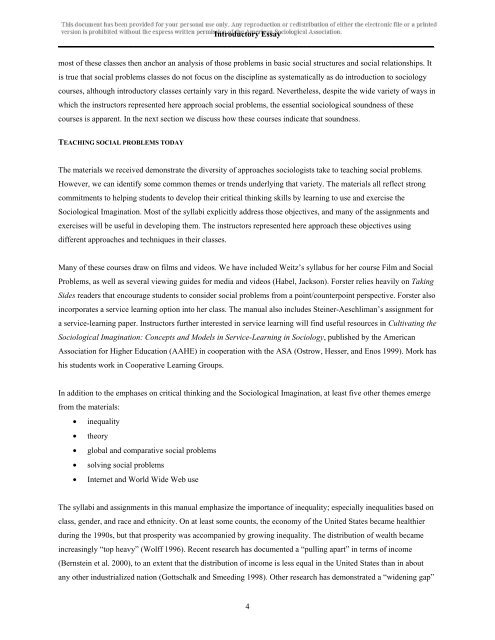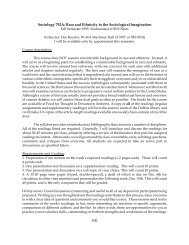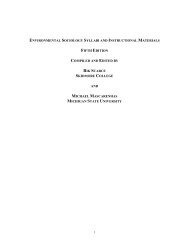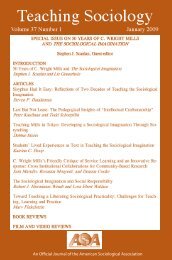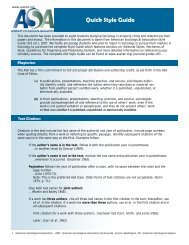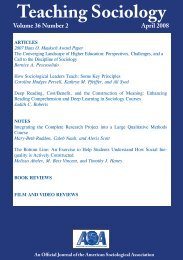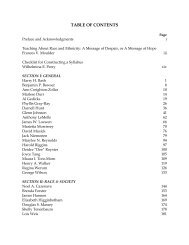Social Problems - American Sociological Association
Social Problems - American Sociological Association
Social Problems - American Sociological Association
You also want an ePaper? Increase the reach of your titles
YUMPU automatically turns print PDFs into web optimized ePapers that Google loves.
Introductory Essay<br />
_____________________________________________________________________________________________<br />
most of these classes then anchor an analysis of those problems in basic social structures and social relationships. It<br />
is true that social problems classes do not focus on the discipline as systematically as do introduction to sociology<br />
courses, although introductory classes certainly vary in this regard. Nevertheless, despite the wide variety of ways in<br />
which the instructors represented here approach social problems, the essential sociological soundness of these<br />
courses is apparent. In the next section we discuss how these courses indicate that soundness.<br />
TEACHING SOCIAL PROBLEMS TODAY<br />
The materials we received demonstrate the diversity of approaches sociologists take to teaching social problems.<br />
However, we can identify some common themes or trends underlying that variety. The materials all reflect strong<br />
commitments to helping students to develop their critical thinking skills by learning to use and exercise the<br />
<strong>Sociological</strong> Imagination. Most of the syllabi explicitly address those objectives, and many of the assignments and<br />
exercises will be useful in developing them. The instructors represented here approach these objectives using<br />
different approaches and techniques in their classes.<br />
Many of these courses draw on films and videos. We have included Weitz’s syllabus for her course Film and <strong>Social</strong><br />
<strong>Problems</strong>, as well as several viewing guides for media and videos (Habel, Jackson). Forster relies heavily on Taking<br />
Sides readers that encourage students to consider social problems from a point/counterpoint perspective. Forster also<br />
incorporates a service learning option into her class. The manual also includes Steiner-Aeschliman’s assignment for<br />
a service-learning paper. Instructors further interested in service learning will find useful resources in Cultivating the<br />
<strong>Sociological</strong> Imagination: Concepts and Models in Service-Learning in Sociology, published by the <strong>American</strong><br />
<strong>Association</strong> for Higher Education (AAHE) in cooperation with the ASA (Ostrow, Hesser, and Enos 1999). Mork has<br />
his students work in Cooperative Learning Groups.<br />
In addition to the emphases on critical thinking and the <strong>Sociological</strong> Imagination, at least five other themes emerge<br />
from the materials:<br />
• inequality<br />
• theory<br />
• global and comparative social problems<br />
• solving social problems<br />
• Internet and World Wide Web use<br />
The syllabi and assignments in this manual emphasize the importance of inequality; especially inequalities based on<br />
class, gender, and race and ethnicity. On at least some counts, the economy of the United States became healthier<br />
during the 1990s, but that prosperity was accompanied by growing inequality. The distribution of wealth became<br />
increasingly “top heavy” (Wolff 1996). Recent research has documented a “pulling apart” in terms of income<br />
(Bernstein et al. 2000), to an extent that the distribution of income is less equal in the United States than in about<br />
any other industrialized nation (Gottschalk and Smeeding 1998). Other research has demonstrated a “widening gap”<br />
4


